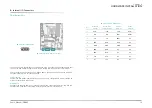
20
User's Manual |
CS631
Chapter 2
HARDWARE INSTALLATION
The USB device allows data exchange between your computer and a wide range of simultane-
ously accessible external Plug and Play peripherals.
In addition to the rear USB ports as introduced previously in this chapter, the system board is
equipped with four internal USB 2.0 ports and 2 USB 3.1 Gen1 ports as illustrated above. USB
11/12 can also be replaced by a Type A vertical connector.
The internal USB pin headers may be connected to a card-edge bracket. Install the card-edge
bracket to an available slot at the rear of the system chassis and then insert the USB port
cables to a connector.
BIOS Setting
Configure the onboard USB in the Advanced menu (“USB Configuration” submenu) of the BIOS.
Refer to chapter 3 for more information.
Wake-On-USB Keyboard/Mouse
The Wake-On-USB Keyboard/Mouse function allows you to use a USB keyboard or USB mouse
to wake up a system from the S state(s).
USB Ports
X
Internal I/O Connectors
VCC
-Data
+Data
GND
Key
VCC
-Data
+Data
GND
N.C.
2
10
1
2
10
1
USB (USB 2.0) Pin Assignment
USB 3.1 Pin Assignment
USB 5/6 (USB 3.1 Gen 1)
USB 9/10 (left), 11/12 (right)
(USB 2.0)
D-
GND
TX+
TX-
GND
RX+
PWR
D+
D-
GND
TX+
TX-
GND
RX+
RX-
PWR
Over Current
Protection
D+
RX-
1
10
11
1
10
11
Note:
The 10-pin header for USB 11/12 ports can be replaced by a vertical Type A con-
nector.















































